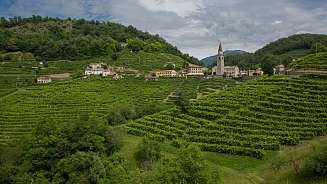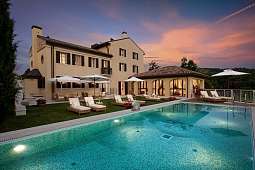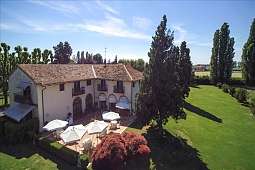Romantik Blog
Journey along the Prosecco Route
It is most beautiful when the evening sun bathes the gentle landscape in a warm light. The freshly poured Prosecco sparkles in the glass, and each sip is a sip of sparkling joie de vivre. The fruity sparkling wine leaves the palate with flavours of apple, peach, pear and a dash of citrus. Just as varied as the bouquet is a journey along the Prosecco Road in Veneto, which runs between the towns of Conegliano and Valdobbiadene. The 42-kilometre route was inaugurated in 1966 and declared Italy's first official wine route.
Past cosy villages

The enjoyment route winds through the vast landscape with historic churches and castles, cosy villages and stately villas that rich Venetians had built here for their summer retreat. The real treasure of the area lies in the lush green vineyards where the gold of the region grows: the yellow Glera grape.
Prosecco production has had to follow strict guidelines since 2010. Only wine made from Glera grapes, grown, produced and bottled in the area between Conegliano and Valdobbiadene, may be called Prosecco. The winegrowers from Veneto now protect their sparkling wine with the DOC and the even higher-quality DOCG seals. They guarantee the authenticity and quality of Prosecco. For a long time, there was no control here, and inferior products from outside the region were also sold under the name Prosecco. This damaged the image of the winegrowers and the reputation of sparkling wine. As a consequence, the producers had their products protected, and the quality seals stand for a controlled origin that meets the quality standards.
Passion and science
A visit to one of the many wineries along the road is worthwhile. Not only to taste, but also to get an impression of the love and passion with which the winegrowers here process the grapes into aromatic Prosecco. If you want to know exactly what it's like scientifically, take a detour to the Scuola Enologica di Conegliano wine school, founded in 1876. In the wine museum, the stages and results of the centuries-old wine culture are exhibited and films provide insights into the history and future of cultivation.

Fascinating contemporary witnesses
With a lot of new wine knowledge in our luggage, the journey continues to San Pietro di Feletto. A worthwhile sightseeing stop. The village offers a magnificent view of the Conegliano hills and is home to one of the oldest parish churches in the area. Some of the frescoes were painted in the 12th century.
The tour continues through woods and past vineyards, downhill towards Refrontolo. A stone architectural jewel invites you to another stop along the way. Embedded in rocks, woods and river water stands the Molinetto della Croda water mill. It was built in the 17th century and ceased operation in 1953. Today it is a fascinating contemporary witness and a popular destination for excursions.
Guardians of Prosecco quality
Continue towards Solighetto to Villa Brandolini, an 18th-century building and headquarters of the Prosecco DOCG Consortium. The association is the guardian of Prosecco quality. The villa is not only about enjoying wine - art exhibitions are also held here regularly.
The hills get steeper on the way to Farra di Soligo. The Castello di Torri di Credazzo stands massive in the landscape, reminiscent of the rule of the Longobards. The Strada del Prosecco continues along the vineyards to Col San Martino. Connoisseurs should approach the small church of San Vigilio on foot. This is the only way to enjoy the panorama and the view of the vineyards with every step.
Fresh wine and genuine classics
In many towns of the Marca Trevigiana, as the province of Treviso used to be called, the Primavera del Prosecco, the spring of Prosecco, takes place every year. This is when the new vintage is tasted and asparagus from the neighbouring growing areas is served. In autumn, local specialities with mushrooms, chestnuts and polenta are served with Prosecco.
Those who would like to drive the route in style in an open, Italian classic car can rent one, for example from Slow drive (info: noleggioautodepoca.eu/it/).
The enjoyable journey ends in Valdobbiadene - the capital of Prosecco production. This is where most of the spumante producers are based. And from here, a final hike into the vineyards and the Trevisan Pre-Alps is worthwhile. If you want to stop for a break along the way - as everywhere along the Prosecco Road, hospitality and tingling joie de vivre are also very important here.
Salute!
The four Prosecco categories
Prosecco Spumante (sparkling wine) is the best known and most popular type. The perlage is fine and long-lasting. It has a light straw-yellow colour and accounts for 76 percent of total production.
Prosecco Frizzante (sparkling wine) comprises 23 percent of total production. The perlage is light and less persistent.
Prosecco col Fondo is the original, time-honoured variant of Prosecco. The wine mousses through natural bottle fermentation and presents itself "col fondo", with the sediment of natural wine yeast, which gives it the aroma of bread crust.
Prosecco Tranquillo (still wine) has no perlage and accounts for one percent of the total production.
The Prosecco Route

Located in the middle of the vineyards. Special feature: wine and prosecco tasting seminars.
Attached is one of the best fish restaurants in Italy, recommended by the famous culinary guide Gambero Rosso.



Hotel tips:
The Romantik Relais d'Arfanta offers guests a relaxing place among Prosecco vineyards and olive groves. The country house has high-quality room facilities and its own pool with a view over the Prosecco vineyards. A tour, which can be booked on site at the hotel, is a wonderful way to explore the area and enjoy the local specialities.
The Romantik Hotel Villa Margherita is located near Venice, in a picturesque meander of the Brenta River and in the middle of a historic park. In the Margherita restaurant, known for its fish specialities, guests enjoy the delicacies of the Veneto according to typical, traditional recipes.
Post your comment
Comments
No one has commented on this page yet.
RSS feed for comments on this page RSS feed for all comments






